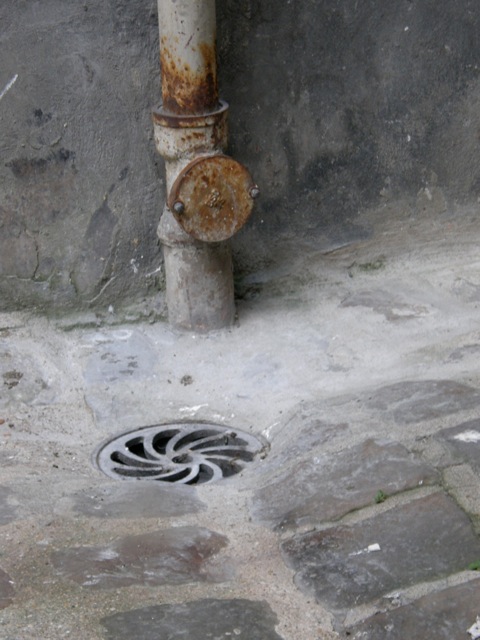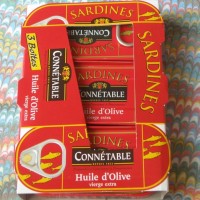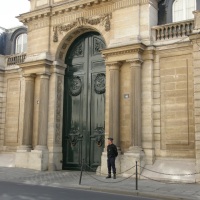Every day, hundreds of thousands of feet pound, skip, saunter, or slog across them. Yet very few people stop to look at the cast iron embedded in Paris’s roads and sidewalks. Some pieces are intricately designed; many glisten with the patina of feet and the passage of time. They are beautiful artworks in their own right, insights into history and clues to the everyday workings of Paris.
Welcome to the world of cast-iron manhole covers, sewer grates, street tree covers, and other pieces of urban street furniture embedded underfoot.
Time and countless feet have polished into high relief this seemingly simple cast-iron manhole cover (the French translation is regard de chaussée or plaque d’égout). The design consists of geometric shapes spaced in concentric rings. The closer we look, the more we see the honourable scars of time.
The manhole covers allow city workers to go beneath the ground to service a labyrinth of pipes, wires, and other necessities of modern urban life. (It also allows urban explorers access to the vast network of tunnels underneath the city.)
Others, such as the one shown above, allow access to the pipes that deliver gas to buildings.
On my first trip to Paris, I was intrigued by the signs that announced “Eau et gaz à tous les étages” (water and gas supplied to all floors) and I still tend to notice these signs on buildings when I walk through the city. Pumped water to all floors meant water for drinking and cooking as well as flushing toilets. Pumped water was a great convenience, but sometimes breakages meant the water supply to the entire building had to be turned off. For the solution to this problem, look down, not up.
Open this kind of access and use a special long-handled tool to turn the valve off. Then the water that was leaking from the broken pipe on the third floor will stop dripping down to the ground floor. (The recriminations are a little harder to stop.)
The Parc de Bercy is a modern urban park in the old wine warehouse area. The buildings that have survived remind us of a former industrial era. Cast-iron covers such as the one shown above speak of another underground technology: telecommunications. And the greenery tells us this cover been here for some time.
I am particularly fond of the image shown above. It bears witness to the way in which trees are respected in Paris. In so many cities—I see this everyday in Toronto—trees are tightly surrounded by impermeable asphalt pavement or bricks. The stunted growth and premature deaths of so many trees on busy urban streets testify to how little water gets through to the roots.
The shape of the grate above intrigues me. Does anyone know who made it? I would love to have one of the two pieces with the straight edges as examples of beautiful industrial design. I would put them in our garden, or even my study, as art objects.
Not all trees survive. However, even in death there is something dignified about the way the trunk has been left to indicate something of interest. The generous grating testifies to the care that allowed the tree to grow to the size it did.
Visitors to Paris are sometimes intrigued—well, okay, I was intrigued—by the collections of exterior drain pipes that collect water from roofs as well as interior waste water (not sewage). Where does the water go? Follow the route of the pipes and you will see.
The cast-iron pipe disappears underground to join the larger water collection system. It collects the water that drains from streets, sidewalks, and courtyards and disappears down drain covers such as this one.
Once you are aware of these features of Paris streets, you will find it is hard to go very far without seeing them. You will also find that if you re-examine many of your photos of Paris street scenes, you will be amazed by the number of drain covers, manhole covers, and other bits of cast iron lurking in your photos. Look closely and try to decipher the clues on each one.
This one came from the foundry of Noel Chadapaux in Paris. Who was he? I am not entirely sure, but Google Books turns up his 1878 patent for “enamelling side culverts.” This is important work in the public health field. The name also led me to a website containing hundreds of photographs of French manhole covers.
When I looked at the manhole cover shown above, I did a double take. There in the streets of Paris was a name I had known as a car-crazed teenager.
I was one of many car fanatics at Delta Secondary School in Hamilton, Ontario. I was particularly inspired by our English teacher, Mr. Smith, a quietly impressive man who owned a screamingly fast Chrysler 300F, which had a fully synchronized Pont-à-Mousson four-speed transmission. Later I would learn that the transmission had proven itself in the Chrysler-powered French luxury car, the Facel Vega.
Back then, all I knew was that Pont-à-Mousson was a factory somewhere in France. Now a manhole cover on the streets of Paris rekindled half-forgotten memories of four-barrel, full-race cams, solid lifters, low-back-pressure-exhaust, and other essential elements of teenaged fantasies.
Thanks to the Internet, I now know that there are others who share my interests. At the website “Manhole Miscellany,” I found out more about Pont-à-Mousson (PAM). The foundry dates back to 1854, but in 1970, along with several other firms, it merged with the firm of Saint-Gobain, which got its start as a firm that made mirrors. Alas, the Pont-à-Mousson bridge across the Moselle River depicted in the company logo (which still appears on all its products) was destroyed in the Second World War.
(My researches also turned up the fact that there is an International Manhole Museum near Venice in Commacchio. Who knew?)
I took the picture above because I liked the bamboo and the colour of the walls in a quiet little enclave. Later I saw the chasse-roue. Now I see the manhole cover and drain.
Or consider this one. It is one of dozens that I have taken for other reasons. But now I see numerous examples of the cast-iron artwork that I previously overlooked.
Baron Haussmann is remembered for creating Paris’s wide boulevards, lined with uniform facades. But let’s not forget that his legacy includes a functional water and wastewater system, bringing eau et gaz to tous les étages while taking away sewage from tous les étages as well. For modern-day Parisians, the second achievement may be even more important than the first.
Text and photographs by Norman Ball.

































Hi there – I’m quite a fan of urban architecture myself, so I enjoyed your article immensely – thank you!
Love the symmetrical beauty of these utilitarian items. Thank you for bringing this to light.
During our stay in Paris this summer, our enjoyment was increased as we looked for the doorways, the wheel guards in entrances, and so many other detalils which your blog had drawn to our attention.
When I dream of going back to Paris, it is always with the hope of returning to the quiet little neighbourhood near the Jardin des Plantes on Rue Linné where we stayed and got to know the neighbourhood and the neighbours in the little bar near our apartment. Need more time in that beautiful city!
Elaine Guillemin and Stephen Swann
I really enjoyed this article. I notice these details because I paint from photographs that capture grates, manhole covers, and the road pedestrian striping in the streets of Paris reflected in the windows of my subjects. I remember seeing an Edward Hopper show and being impressed by how he used the telephone pole and wires in his paintings and drawings to add tension and direction, as well as capturing what was really there. I have always been amazed at how many of those tree grates have trapped countless cigarette butts. I also know enough about walking the streets of Paris to watch where I step to avoid dog deposits and that allows me to see many other things at pavement level as well! Thank you for your photos and story.
Richard Ewen
Actually, I’ll share one of my all time favoutite iPhone pics with you here, because it’s SO apposite!
Cheers, Sab http://bit.ly/cgdILO
Je suis tellement contente d’avoir découvert ce merveilleux blog, vous avez beaucoup de chance d’habiter à Paris! Continuez le bon travail 🙂
When I was there last year a lot of simple manhole covers had been sprayed to look like record albums.
There is (was?) a guy on Flickr.com who posted tons of manhole covers, a very kind person. I say ‘was’ because I am not sure that he is still posting, he might have died even…. but give it a try you’d would surely find a soul brother!
Impressive and interesting – I find little things every day that enrich my life – those mostly overlooked items are part of those finds. You are to be praised for bringing them to attention. Thanks!
Pingback: Reminders of Paris in Greenwich and London | Parisian Fields
Great article! Here’s one I’m intrigued about:
http://tinyurl.com/jwzsut6
Recall reading somewhere that it is a cistern cover supping water to the louvre castle. Anyone know where this is? Cour Carré?